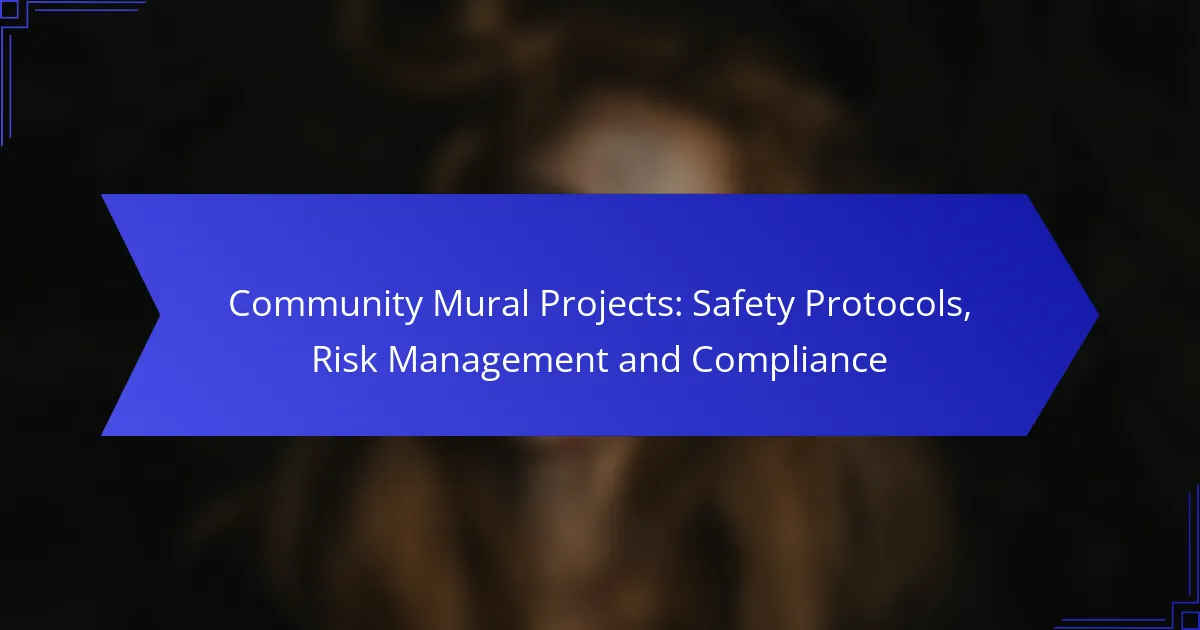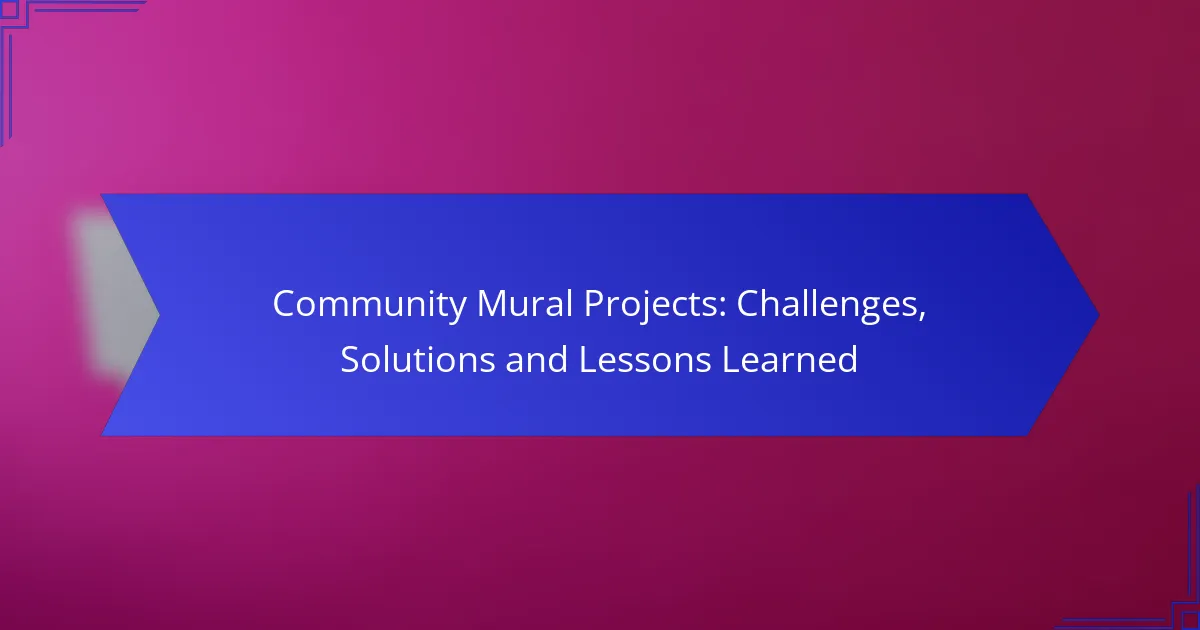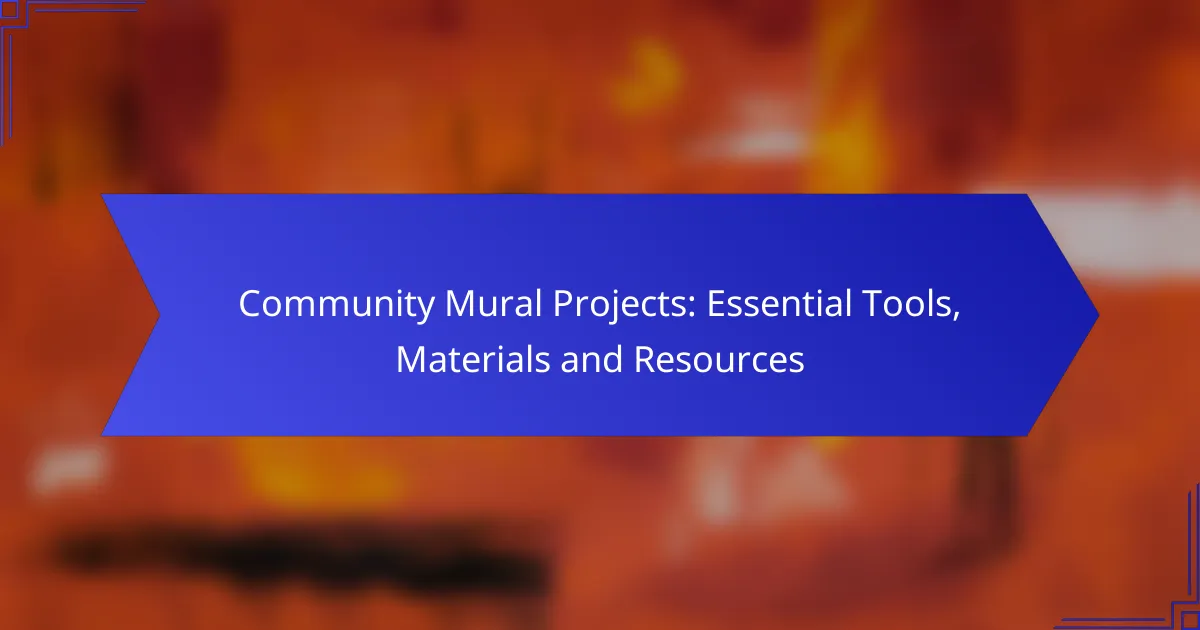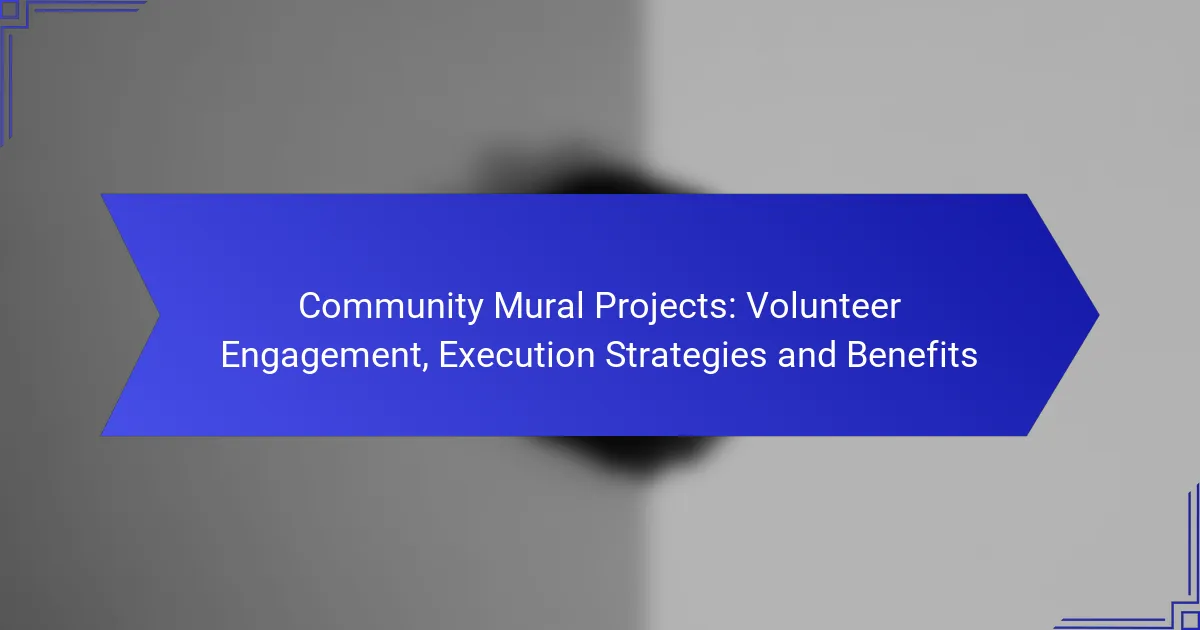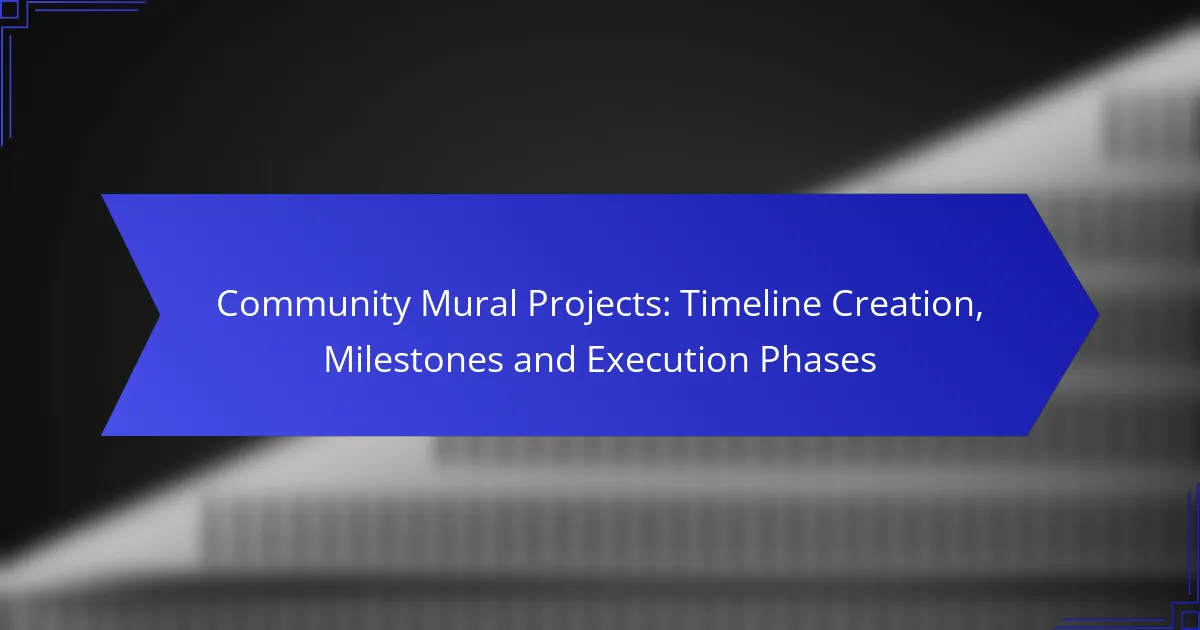Community mural projects require stringent safety protocols to ensure the well-being of artists, volunteers, and the public. By identifying potential hazards and implementing risk management strategies, these initiatives can thrive while adhering to local compliance regulations, such as obtaining necessary permits and following zoning laws. Engaging the community and providing training further enhances safety and fosters a collaborative environment for artistic expression.
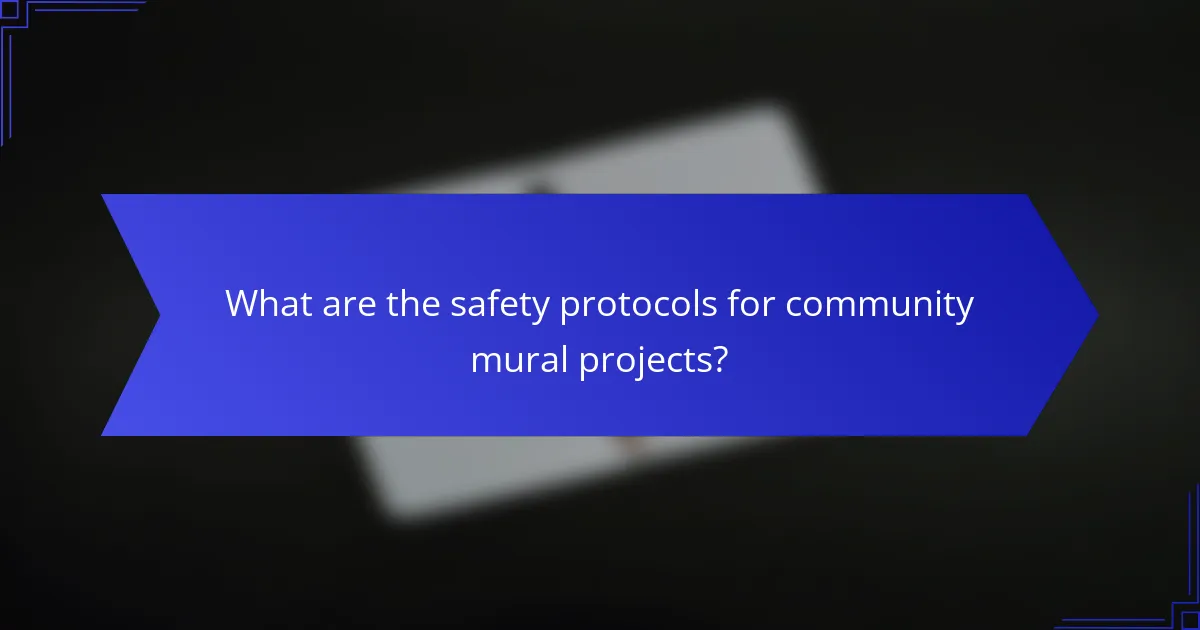
What are the safety protocols for community mural projects?
Safety protocols for community mural projects are essential measures designed to protect artists, volunteers, and the public during the creation of murals. These protocols encompass the use of personal protective equipment, site safety assessments, emergency response plans, and community engagement and training.
Use of personal protective equipment (PPE)
The use of personal protective equipment (PPE) is crucial in ensuring the safety of participants in mural projects. Common PPE includes gloves, masks, goggles, and hard hats, depending on the materials and techniques used. For instance, when working with spray paint, masks that filter out harmful fumes are essential.
Before starting, project coordinators should conduct a PPE inventory to ensure all participants have access to the necessary equipment. Regular checks should be made to replace any damaged or worn-out gear to maintain safety standards.
Site safety assessments
Site safety assessments involve evaluating the mural location for potential hazards before work begins. This includes checking for uneven surfaces, nearby traffic, and overhead power lines. A thorough assessment helps identify risks that could lead to accidents or injuries.
Project leaders should document findings and create a safety plan that addresses identified risks. Regular reassessments during the project can help adapt to any new hazards that may arise as work progresses.
Emergency response plans
Emergency response plans outline the steps to take in case of an accident or injury during the mural project. These plans should include contact information for local emergency services, procedures for reporting incidents, and first aid protocols. Having a designated first aid station on-site is advisable.
Training participants on the emergency response plan before starting work ensures everyone knows how to react in a crisis. Regular drills can reinforce this knowledge and improve overall safety awareness among team members.
Community engagement and training
Community engagement and training are vital for fostering a culture of safety within mural projects. Involving local residents in safety training sessions can empower them to take an active role in maintaining a safe environment. This can include workshops on proper use of tools and equipment.
Additionally, creating an open line of communication allows community members to voice concerns or suggestions regarding safety. This collaborative approach not only enhances safety but also strengthens community ties and ownership of the mural project.

How to manage risks in community mural projects?
Managing risks in community mural projects involves identifying potential hazards, assessing those risks, and implementing strategies to mitigate them. A proactive approach ensures the safety of artists and the community while maintaining compliance with local regulations.
Identifying potential hazards
Identifying potential hazards is the first step in risk management for community mural projects. Common hazards include working at heights, exposure to harmful materials, and environmental factors such as weather conditions. Engaging with local artists and community members can help uncover specific risks related to the project site.
Consider conducting a walkthrough of the mural location to spot any obvious dangers, such as unstable surfaces or nearby traffic. Documenting these hazards will provide a clear reference for the next steps in risk management.
Risk assessment frameworks
Risk assessment frameworks help organize and evaluate the identified hazards systematically. A common approach is to use a matrix that categorizes risks based on their likelihood and potential impact. This method allows project leaders to prioritize which risks need immediate attention.
For example, a risk that poses a high likelihood of occurrence and significant impact, such as falling from a ladder, should be addressed before lower-priority risks. Utilizing established frameworks, such as the ISO 31000 standard, can enhance the effectiveness of the assessment process.
Mitigation strategies
Mitigation strategies are essential for reducing the likelihood and impact of identified risks. Implementing safety measures such as using harnesses when working at heights, providing proper training for artists, and ensuring the use of non-toxic materials can significantly lower risks. Regular safety briefings can reinforce these practices among team members.
Additionally, creating an emergency response plan that outlines procedures for accidents or injuries can further enhance safety. Regularly reviewing and updating these strategies based on feedback and incidents will help maintain a safe working environment throughout the mural project.

What are the compliance requirements for mural projects in urban areas?
Compliance requirements for mural projects in urban areas typically involve obtaining permits, adhering to local zoning laws, and following environmental regulations. These requirements ensure that the projects align with community standards and legal frameworks.
Permitting processes
Before starting a mural project, artists or organizations must navigate the permitting processes specific to their city or municipality. This often includes submitting an application that outlines the project details, location, and design for review by local authorities.
Commonly, the permitting process may take several weeks, and fees can vary widely, typically ranging from a few dozen to several hundred dollars. It’s crucial to check with local government offices for specific requirements and timelines.
Local zoning laws
Local zoning laws dictate where murals can be placed and under what conditions. These regulations may restrict murals to certain districts or require compliance with aesthetic guidelines to maintain neighborhood character.
Understanding zoning classifications is essential; for instance, commercial zones may have different allowances compared to residential areas. Engaging with local zoning boards early in the project can help avoid costly adjustments later.
Environmental regulations
Environmental regulations can impact mural projects, especially regarding the materials used and the potential effects on local ecosystems. Artists should consider using environmentally friendly paints and materials to comply with sustainability initiatives.
In some areas, regulations may also require assessments to ensure that the mural does not negatively affect wildlife or natural resources. Consulting with environmental agencies can provide clarity on necessary compliance measures.

What are the best practices for community involvement in mural projects?
Effective community involvement in mural projects hinges on collaboration, feedback, and inclusivity. Engaging local residents and stakeholders ensures that the mural reflects the community’s identity and values, fostering a sense of ownership and pride.
Collaborative design sessions
Collaborative design sessions bring together artists, community members, and stakeholders to brainstorm ideas and concepts for the mural. These sessions should be structured to encourage open dialogue, allowing participants to share their visions and preferences. Utilizing tools like sketching or digital mock-ups can help visualize ideas and facilitate discussion.
Consider hosting multiple sessions to accommodate different schedules and ensure diverse participation. Providing refreshments and a welcoming environment can enhance engagement and creativity during these meetings.
Feedback mechanisms
Implementing feedback mechanisms is crucial for refining mural designs based on community input. Surveys, comment boxes, or online platforms can be used to gather opinions on proposed designs. This feedback loop not only improves the final artwork but also strengthens community ties by showing that residents’ voices are valued.
Ensure that feedback is collected at various stages of the project, from initial concepts to final designs. This approach allows for adjustments based on community sentiment and can prevent potential conflicts or dissatisfaction later on.
Inclusive participation strategies
Inclusive participation strategies aim to engage a broad spectrum of community members, including marginalized groups. This can be achieved by promoting the project through various channels, such as local schools, community centers, and social media platforms, ensuring that information reaches diverse audiences.
Consider offering workshops or activities that cater to different age groups and skill levels, allowing everyone to contribute meaningfully. Providing materials and resources for those who may not have access can further enhance inclusivity and participation in the mural project.

What tools can assist in risk management for mural projects?
Effective risk management for mural projects can be enhanced by utilizing various tools that streamline planning, communication, and compliance. Key tools include project management software, risk assessment templates, and collaboration platforms that help teams identify and mitigate potential risks throughout the project lifecycle.
Project management software
Project management software is essential for organizing tasks, timelines, and resources in mural projects. These tools allow project managers to assign responsibilities, track progress, and ensure that deadlines are met while maintaining safety protocols.
When selecting project management software, consider features such as task assignment, Gantt charts, and budget tracking. Popular options include Trello, Asana, and Monday.com, which can help teams visualize their workflow and identify potential bottlenecks.
To maximize effectiveness, establish clear guidelines for using the software, ensuring all team members are trained and engaged. Regularly review project progress and adjust plans as needed to address any emerging risks or compliance issues.






